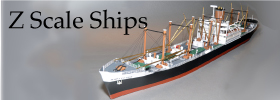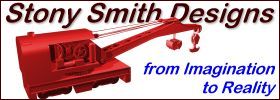- Posts: 9
- Thank you received: 0
Soldering Track
- makotom01
- Offline
- New Member
-

Thanks again,
Tom:S
Please Log in or Create an account to join the conversation.
- David K. Smith
- Offline
- Premium Member
-

- Posts: 446
- Thank you received: 40
Also, a good flux helps quite a bit. I avoid any paste-type fluxes as they are grease-based, making it more difficult to clean away the residue (and residue can corrode the rail); my recommendation is a liquid flux such as Stay-Clean (available through Micro-Mark Tools), which is water-based. You ony need a tiny amount of it to work.
Please Log in or Create an account to join the conversation.
- tealplanes
- Offline
- Dispatcher
-

- Posts: 774
- Thank you received: 64
Soldering is not difficult if done correctly. Use a hot enough iron, make sure the tip is clean and tinned and apply a little flux. I use silver solder, it melts at a lot temp and does fine. Apply a little flux to the outside of the joint and heat the rail joiner and then apply solder to the edge of the rail joiner. Solder should wick into the joint easily.
Loren
Please Log in or Create an account to join the conversation.
- makotom01
- Offline
- New Member
-

- Posts: 9
- Thank you received: 0
Tom
Please Log in or Create an account to join the conversation.
- David K. Smith
- Offline
- Premium Member
-

- Posts: 446
- Thank you received: 40
Thanks Loren and David. I am going to use a couple of alligater clips, clipped on the rails as heat sinks.
That's a good conservative approach. Once you get the hang of it, soldering a rail joint should take at most about two seconds. At which point the heat sinks won't be needed.
Please Log in or Create an account to join the conversation.
- mhommer
- Offline
- New Member
-

- Posts: 53
- Thank you received: 2
Mike
Please Log in or Create an account to join the conversation.
- David K. Smith
- Offline
- Premium Member
-

- Posts: 446
- Thank you received: 40
Always with rail joiners. Soldering just the rail ends would have no strength; the joints would easily break.Another general soldering questions. When connecting the track sections do you leave the rail joiners in place and just solder over them? Or are you carefully aligning the ends and soldering them in place to complete the connection instead of the rail joiners?
Please Log in or Create an account to join the conversation.
- SJ-BAZ-man
- Offline
- DCC Moderator
-

- Posts: 197
- Thank you received: 4
David gives good advice on soldering. Most solders with the proper temperature iron should heat within a second, especially if you place the solder between the iron and track. The melting solder will help create a much larger surface area to transfer the heat the rail and you will quickly know you have solder whetting of the rail. Solders have flux in them designed to cut the crud but you make have to clean old stuff. If the solder doesn't stick after it near instantly melts when touched to the tip, you may want to clean the rail a bit. 99% of the time, you should not have to. Alcohol or chemical spray, abrasive (like a file or very fine sandpaper) or wire brush a bit.
Make sure if you solder on the inside of the rail joiner that the extra solder does not ball up on the joiner, interfering with the wheel flanges. I solder my track feeders to the bottom of the rail joiner, then slip in the track. I don't solder the rail. I made that mistake early on and had out of gauge track with the temperature range of winter gararge to modules in the car.
Z gauge locos commonly draw < 0.05 Amps (50 milliamps). A piece of #26 wire (like home telephone wiring) will lose 0.0025Volts (that's 2.5 millivolts over 24 feet of wire. Your rail (and joiners) are MUCH better than that ! So maybe you run 1 old MTL F7 loco or 10 of your favorite newer locos, the much greater current would still only loose approx .05-.075 V using that same small wire. You would never see the speed change in one loco if you placed all 9 of the others on the track (assuming you had a proper power supply).
Now go run your trains ! More fun to watch them run
Jeff
SF Bay Area Z
Please Log in or Create an account to join the conversation.
- zthek
- Offline
- Junior Member
-

- Posts: 137
- Thank you received: 0
Solders have flux in them designed to cut the crud but you make have to clean old stuff.
The rosin core (flux) inside of solder is (my humble opinion) worthless for track soldering. As David suggested, good, stinky, liquid flux works wonder. The residues need to be rinsed away, but the strength of solder joints worth the extra effort.
So maybe you run 1 old MTL F7 loco or 10 of your favorite newer locos
The old F7s are my favorite, it's a miracle
Lajos:)
Please Log in or Create an account to join the conversation.
- dominique
- Offline
- Junior Member
-

- Posts: 136
- Thank you received: 3
mhommer wrote:
Always with rail joiners. Soldering just the rail ends would have no strength; the joints would easily break.Another general soldering questions. When connecting the track sections do you leave the rail joiners in place and just solder over them? Or are you carefully aligning the ends and soldering them in place to complete the connection instead of the rail joiners?
Furthermore, in my opinion it's pretty difficult to have a correct alignment without a joiner. And with our beloved tiny scale an uncorrect alignment doesn't forgive.
Dom
Please Log in or Create an account to join the conversation.
- dominique
- Offline
- Junior Member
-

- Posts: 136
- Thank you received: 3
The tunnels is about the only place I would solder. Everything else should run reliably, unless you live in a really crappy oxidizing industrial environment (like smokers, factory, etc.) The electrical current requirements of Z are SOoooo low that they do not require soldering like the larger, much more power hungry O scale layouts. You will have a 1000x more problems with loco-to-track crap than with a rail joiner. Trust me (an electrical engineer), you will be fine without soldering (except for the tunnel). If you live in a wide temperature extreme environment, then I definetely do not recomment soldering the track !!
Jeff
SF Bay Area Z
Hi Jeff, it's good to read all what you write above. However, maybe I'm a little bit fool but I definitly prefer soldering. OK, in my case I've no choice as I only use flextrack on my layout, but:
-my layout is indeed inside an "hostile meterological environment" (a room with no thermic isolation, ie heated in summer and air conditionned in winter:laugh: , and with a little moisture). As I soldered all my track sections together (unless those that have to be isolated, that are linked with a switch) and as I soldered feeders to every track section, I've experienced no loose contact so far.
-meanwhile I worked on a very tiny layout for my stepson, made with MTL sectional track and turnouts. I tried not do what I'm speaking of above, and I'm not very pleased with the result as the MTL Geep I'm using as a guinea pig seems a little bit jerky on it. I think I'll have some more work on it in order to add feeders...
Dom
Please Log in or Create an account to join the conversation.
- SJ-BAZ-man
- Offline
- DCC Moderator
-

- Posts: 197
- Thank you received: 4
Here is the HO version, they have an N one:
www.eurorailhobbies.com/erh_detail.asp?MN=2&CA=13&SC=HO&stock=T66628
Please Log in or Create an account to join the conversation.
- dominique
- Offline
- Junior Member
-

- Posts: 136
- Thank you received: 3
Dom
Please Log in or Create an account to join the conversation.
- ZFRANK
- Offline
- New Member
-

- Posts: 33
- Thank you received: 3
"feeded" every track section...
Dom
That is the way to go, solder feeders to every piece of track. This way rails can shrink and expand when having huge temperature differences...
/Frank
Please Log in or Create an account to join the conversation.
















